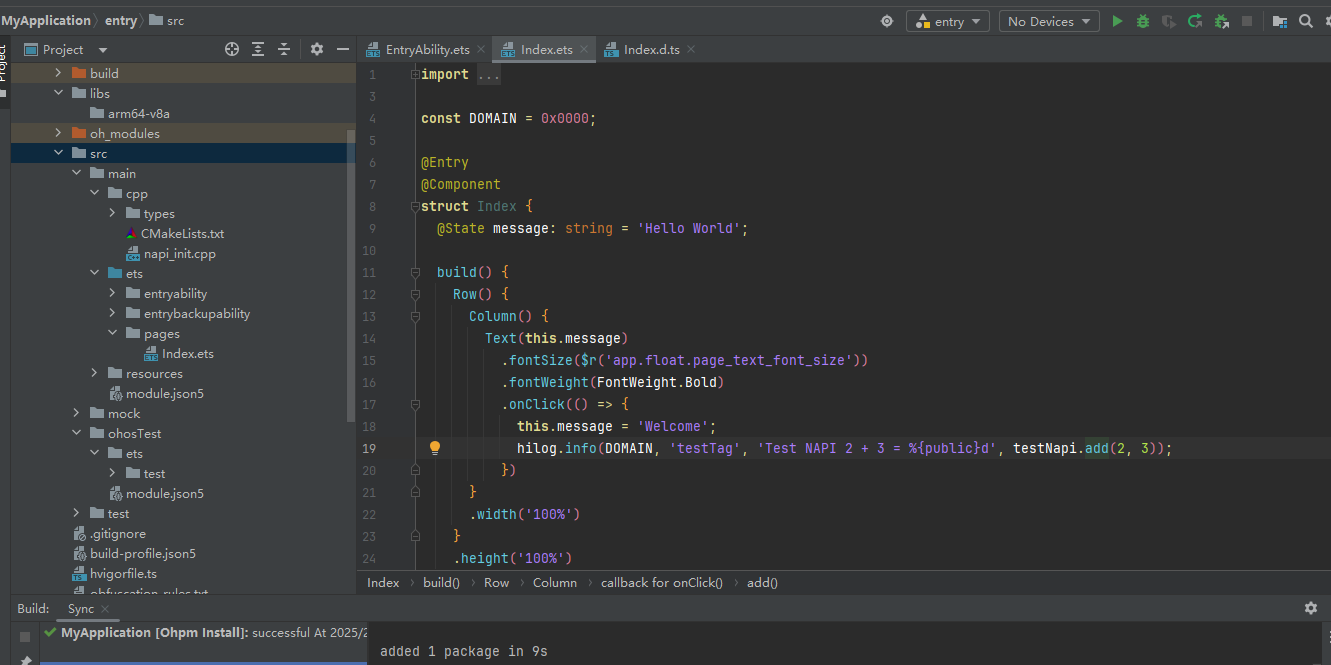harmony 鸿蒙获取设备的位置信息开发指导(C/C++)
获取设备的位置信息开发指导(C/C++)
场景介绍
开发者可以调用OpenHarmony位置相关接口,监听设备的位置变化。
函数说明
| 名称 | 描述 |
|---|---|
| OH_Location_IsLocatingEnabled(bool* enabled) | 查询位置开关是否开启。 |
| OH_Location_StartLocating(const Location_RequestConfig* requestConfig) | 启动定位并订阅位置变化。 |
| Location_ResultCode OH_Location_StopLocating(const Location_RequestConfig* requestConfig) | 停止定位并取消订阅位置变化。 |
| OH_LocationInfo_GetBasicInfo(Location_Info* location) | 从定位结果中获取基本信息,如经纬度、海拔、速度等信息。 |
| OH_LocationInfo_GetAdditionalInfo(Location_Info* location, char* additionalInfo, uint32_t length) | 从定位结果中获取附加信息。附加信息是一个JSON格式的字符串。 |
| OH_Location_CreateRequestConfig(void) | 创建一个位置请求参数结构体实例。 |
| OH_Location_DestroyRequestConfig(Location_RequestConfig* requestConfig) | 销毁位置请求参数实例并回收内存。 |
| OH_LocationRequestConfig_SetUseScene(Location_RequestConfig* requestConfig, Location_UseScene useScene) | 设置发起定位时的用户活动场景。 如果设置了useScene,则powerConsumptionScene无效。 如果未设置useScene,且设置了powerConsumptionScene,则该参数生效。 如果两个参数都不设置,则默认useScene为LOCATION_USE_SCENE_DAILY_LIFE_SERVICE,powerConsumptionCenario参数无效。 |
| OH_LocationRequestConfig_SetPowerConsumptionScene(Location_RequestConfig* requestConfig, Location_PowerConsumptionScene powerConsumptionScene) | 设置发起定位时的功耗场景。 |
| OH_LocationRequestConfig_SetInterval(Location_RequestConfig* requestConfig, int interval) | 设置定位结果上报时间间隔。 |
| OH_LocationRequestConfig_SetCallback(Location_RequestConfig* requestConfig, Location_InfoCallback callback, void* userData) | 设置用于接收位置上报的回调函数。 |
开发步骤
新建一个Native C++工程。

获取设备的位置信息,需要有位置权限,位置权限申请的方法和步骤见申请位置权限开发指导。
CMakeLists.txt文件中引入动态依赖库。
target_link_libraries(entry PUBLIC libace_napi.z.so)
target_link_libraries(entry PUBLIC libhilog_ndk.z.so)
target_link_libraries(entry PUBLIC liblocation_ndk.so)
- 在napi_init.cpp文件中编码,首先导入模块。
#include "napi/native_api.h"
#include "LocationKit/oh_location.h"
#include "LocationKit/oh_location_type.h"
#include "hilog/log.h"
#include <stdlib.h>
- 调用获取位置接口之前需要先判断位置开关是否打开。 查询当前位置开关状态,返回结果为布尔值,true代表位置开关开启,false代表位置开关关闭,示例代码如下:
static napi_value OhLocationIsEnabled(napi_env env, napi_callback_info info)
{
bool isEnabled = false;
int resultCode = OH_Location_IsLocatingEnabled(&isEnabled);
napi_value result = NULL;
napi_get_boolean(env, isEnabled, &result);
return result;
}
// 在Init函数中补充接口。
EXTERN_C_START
static napi_value Init(napi_env env, napi_value exports)
{
napi_property_descriptor desc[] = {
{"ohLocationIsEnabled", NULL, OhLocationIsEnabled, NULL, NULL, NULL, napi_default, NULL},
};
napi_define_properties(env, exports, sizeof(desc) / sizeof(desc[0]), desc);
return exports;
}
EXTERN_C_END
定位位置变化。
// 定义一个请求参数 struct Location_RequestConfig *g_requestConfig = NULL; void *mydata = NULL; // 定义一个回调函数用来接收位置信息 void reportLocation(Location_Info* location, void* userData) { Location_BasicInfo baseInfo = OH_LocationInfo_GetBasicInfo(location); char additionalInfo[1024] = ""; Location_ResultCode result = OH_LocationInfo_GetAdditionalInfo(location, additionalInfo, sizeof(additionalInfo)); if (mydata == userData) { OH_LOG_INFO(LOG_APP, "userData is mydata"); } return; } // 订阅位置信息 static napi_value OhLocationStartLocating(napi_env env, napi_callback_info info) { if (g_requestConfig == NULL) { g_requestConfig = OH_Location_CreateRequestConfig(); } OH_LocationRequestConfig_SetUseScene(g_requestConfig, LOCATION_USE_SCENE_NAVIGATION); OH_LocationRequestConfig_SetInterval(g_requestConfig, 1); mydata = (void *)malloc(sizeof("mydata")); // 用户自定义任意类型,callback 透传返回 OH_LocationRequestConfig_SetCallback(g_requestConfig, reportLocation, mydata); OH_Location_StartLocating(g_requestConfig); int32_t ret = 0; napi_value result = NULL; napi_create_int32(env, ret, &result); return result; } //取消订阅位置信息, g_requestConfig要和订阅时传入的对象保持一致 static napi_value OhLocationStopLocating(napi_env env, napi_callback_info info) { OH_Location_StopLocating(g_requestConfig); if (g_requestConfig != NULL) { OH_Location_DestroyRequestConfig(g_requestConfig); g_requestConfig = NULL; } free(mydata); mydata = NULL; int32_t ret = 0; napi_value result = NULL; napi_create_int32(env, ret, &result); return result; } // 在Init函数中补充接口。 EXTERN_C_START static napi_value Init(napi_env env, napi_value exports) { napi_property_descriptor desc[] = { {"ohLocationStartLocating", NULL, OhLocationStartLocating, NULL, NULL, NULL, napi_default, NULL}, {"ohLocationStopLocating", NULL, OhLocationStopLocating, NULL, NULL, NULL, napi_default, NULL}, }; napi_define_properties(env, exports, sizeof(desc) / sizeof(desc[0]), desc); return exports; } EXTERN_C_END在types/libentry路径下index.d.ts文件中引入Napi接口。
export const ohLocationIsEnabled: () => boolean; export const ohLocationStartLocating: () => number; export const ohLocationStopLocating: () => number;删除Index.ets中的已废弃函数。
.onClick(() => { hilog.info(0x0000, 'testTag', 'Test NAPI 2 + 3 = %{public}d', testNapi.add(2, 3)); })
你可能感兴趣的鸿蒙文章
harmony 鸿蒙FenceExtensionAbility
harmony 鸿蒙地理编码转化与逆地理编码转化开发指导(ArkTS)
0
赞
- 所属分类: 后端技术
- 本文标签:
热门推荐
-
2、 - 优质文章
-
3、 gate.io
-
7、 openharmony
-
9、 golang